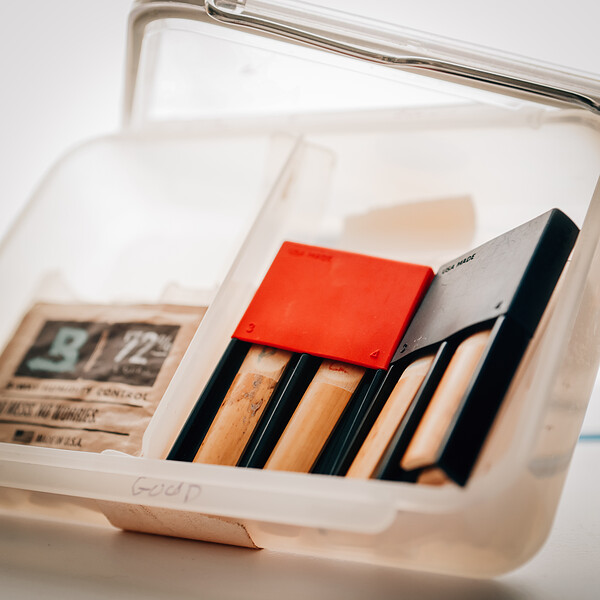How can I improve my reeds?

15 April 2019
Many students and professionals ask me, “How can I improve my reeds?”This question comes with the expectation that I will be passing on advice or a method of adjusting a reed with a knife or sandpaper. All are surprised when I say that I NEVER work on my reeds and that I confiscate my students’ reed knives and adjusting tools on their first day of lessons with me at the Shepherd School of Music at Rice University. Instead of giving them a claim check for their confiscated knives, I give them a Tupperware box with a humidity pack inside of it, or a reed storage case (also with a humidity pack inside).
One week after this exchange of reed knife for humidity control, my students all remark about how stable and consistent their reeds have become. This is because their reeds are no longer going from 100% humidity (a wet reed after playing) to the 20-30% humidity of their daily surroundings, which happens when they are left out in the open to dry. This rapid and damaging drying of a reed occurs when the reed is just placed into a clarinet case, case pocket, or even left out on a stand or table. These are the main causes for reed warpage and also the dreaded “potato chip tip.” I call it that because a reed that dries rapidly to below 50% humidity can get a tip that looks like a Ruffles potato chip! This is extreme warpage! Once a reed gets to this point, it will have lost its clarity, response and depth of sound.
Some will argue with me, saying “I live in Houston and its 90% humidity outside… I don’t need one of those humidity packs…,” etc. What those skeptics fail to realize is that in the most humid cities, the air conditioning is cranked up full blast all of the time, thus making the indoor humidity below 30%.
The other advantage of putting your reeds in a humidity controlled environment is that they have a chance to start to acclimate to a consistent environment right away upon opening the box. This is especially true if you ordered your reeds and they traveled to you via plane, train, or truck through many different temperatures and environments. A humidity-acclimated box of reeds will yield a higher number of great reeds than one that has not stabilized in this manner. I recommend unwrapping the cellophane from a new box of reeds and placing it in a humidity-controlled box or bag for one to three weeks before trying them. I guarantee that you will find more terrific reeds than ever before.
Give your reeds a little bit of humidity and TLC, and they will be there for you when you need them to be at their best.
POSTSCRIPT
Since this was shared so much on Facebook I have received wonderful questions about my process. Some have asked which level of humiditypack to use.
The answer is: learn and understand the humidity in your box first. Having a hygrometer in there would identify the situation. I keep 59% in my box when it is dry outside or indoors. But in places like Santa Barbara in the summer (with no AC running and drying things out indoors), I dont even use a humidty pack! Knowing the ecosystem in the box via a hygrometer is telling. The bottom line is that preventing rapid changes and keeping a stable environment is critical.